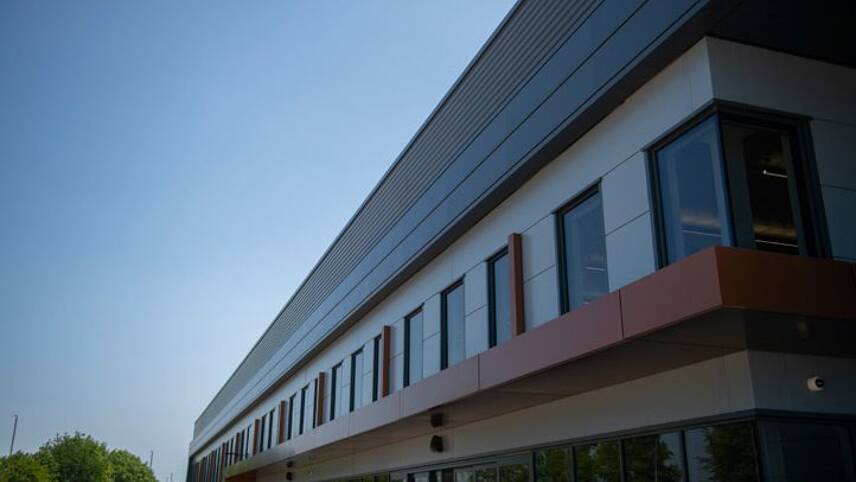Register for free and continue reading
Join our growing army of changemakers and get unlimited access to our premium content

More than £60m of specialist manufacturing equipment is in the final stages of commissioning
The £130m UK Battery Industrialisation Centre (UKBIC) is one of the key components of the Faraday Battery Challenge, which is funded through the Department for Business, Energy and Industrial Strategy’s (BEIS) Industrial Strategy Challenge Fund.
The Centre will be a first of its kind development facility in Coventry to help develop and fast track batteries that are recyclable, cost-effective and high performance.
The 18,500 square metre publicly funded facility is set to become operational in the near future, and has started welcoming customers. Any organisation can access the facility if they have new or existing battery technologies and the facility can be used to test technological viabilities to see whether they can be manufactured at volume and whether they can be commercially successful.
UKBIC’s managing director Jeff Pratt said: “We’re really excited to be getting close to being operational and playing a key role in developing and stimulating the race to a greener future. Since moving into our new facility earlier this year, we have already begun to welcome manufacturers, entrepreneurs, researchers and educators, albeit in a controlled and socially distanced manner.”
“Our battery production development facility can be used by companies working on electric vehicles, rail, aerospace, industrial and domestic equipment and static energy storage, who can benefit by finding out whether their innovations can be scaled up successfully before committing to the huge investment needed for mass production.”
The UKBIC received planning permission two years ago. More than £60m of specialist manufacturing equipment is in the final stages of commissioning. The facility will also provide opportunities for hands-on training in battery production
Currently, UKBIC employs 86 people – a mixture of technicians, engineers and consultants. The Centre hopes to employ more than 100 people moving forward.
Earlier this week, the UK’s largest battery came online in South Yorkshire. Gresham House has announced that its 50MW, 75MWh battery storage array in Thurcroft, South Yorkshire, is now live.
The UK Government has moved to relax planning rules for large-scale energy storage arrays in a bid to help the sector compete competitively. Under previous Nationally Significant Infrastructure Projects (NSIP) requirements, special approval was needed for arrays over 50MW.
The Faraday Battery Challenge’s Industrial Strategy Challenge director Tony Harper said: “I’m delighted that three years after it was just a concept, UKBIC is already on its way to becoming a world-class battery manufacturing facility. It will enable us to deploy battery technology at scale, build new supply chains, and through the combination of Government and industry, help develop cost-effective, high-performance, durable, safe, low-weight and recyclable batteries which will be vital to meet the increasing demand of the global battery market.
“The facility will help unlock the economic value to the UK of battery development during the country’s transition to a net-zero economy, and will be made possible through the collaboration of manufacturers, entrepreneurs, researchers, and educators who will use it.”
the Faraday Institution plans to split a £55m funding pot between five UK-based research and development projects surrounding battery energy storage for EVs.
Each of the projects to receive support under the new round of funding will run for four years. They are:
- Nextrode – A project at the University of Oxford working to transform the way electrodes for lithium-ion batteries are manufactured. Led by researchers, the project will draw on the expertise of five other universities (University of Birmingham, University College London, University of Sheffield, University of Southampton and University of Warwick )and six external businesses. Its aim is to develop electrodes that could extend battery life and help usher in the next generation of “smart” electric vehicles (EVs).
- FutureCat – The University of Sheffield’s project centred on delivering cathodes that hold more charge and are better suited to withstand prolonged cycling and promote ion mobility while reducing the dependency of cell manufacturers on cobalt.
- CAMAT – The University of Bath’s research into innovative cathode materials, in a bid to minimise the environmental impact of battery life-cycles.
- NEXGENNA – The University of St Andrews’ R&D scheme surrounding sodium ion batteries. In partnership with three businesses, five overseas research bodies and five UK laboratories, the project will seek to put sodium ion batteries on the path to commercialisation while maintaining performance and safety.
- The Lithium-Sulfur Technology Accelerator (LiSTAR) – UCL’s join scheme centred around enabling rapid improvements in lithium-ion technologies through research at material, cell and system level.
The development and industrialisation of recycling technologies for end-of-life electric vehicle (EV) batteries is currently being outpaced by a boom of EV uptake, paving the way for a “huge waste management problem” in decades to come.
That is according to new research led by a team of experts at the University of Birmingham, which calculated that the one million EVs sold in the UK in 2017 alone will generate 250,000 tonnes of battery waste when they reach the end of their lives – likely in the early-to-mid-2030s.
Experts believe there is not enough cobalt in the world to replace every working petrol or diesel vehicle on the roads with fully electric alternatives. Moreover, batteries are typically warrantied for less than 15 years and considered hard to recycle, even though they contain high proportions of recyclable and high-value metals. The good news is that the likes of BMW, Nissan and Formula E are beginning to invest heavily in more circular battery products and systems, and that startups in this space are continuing to innovate.
Matt Mace


Please login or Register to leave a comment.